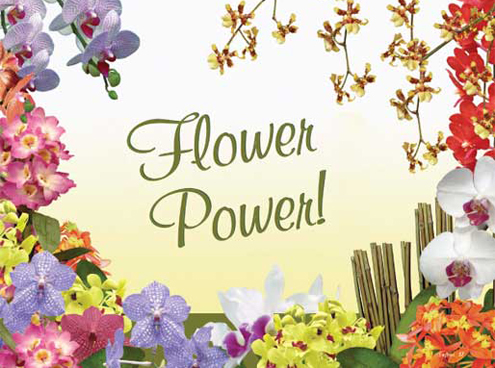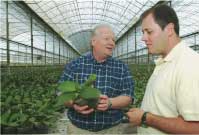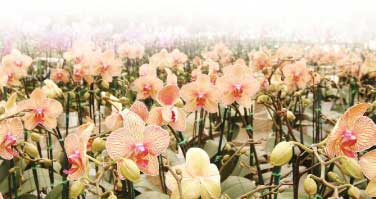|
|
 Orchids are the Fastest-Growing Segment of the Nation's $13 Billion Floriculture IndustryBy Chuck Woods Often described as the most beautiful flowers in the world, orchids have a distinct and undeniable mystique. But beauty alone cannot explain our fascination with orchids. When it comes to variety, complexity and elegance, orchids are unlike any other plant. With more than 25,000 identified species and 120,000 registered hybrids, they are the largest group of flowering plants - and the fastest-growing segment of the nation's $13 billion floriculture and nursery crops industry. In Florida, where large-scale production of orchids is booming, the University of Florida's Institute of Food and Agricultural Sciences, or IFAS, is While orchids are common in the tropics, they also grow wild under different climatic conditions on every continent except Antarctica. In North America, orchid species are native to every state - including Alaska where "arctic orchids" have been identified.
Throughout South America during the 16th century, English explorers pioneered orchid hunting, and there are many accounts of hunters vanishing in the jungles without a trace. Once just a hobby for the landed gentry with the money, time and patience to care for these exotic plants, orchid growing is now an international business, and Florida has become one of the nation's top commercial producers. "Next to poinsettias, orchids are now the leading potted flowering plant produced in Florida, generating more than $23 million in annual farmgate sales," says Terril Nell, professor and chair of UF's Department of Environmental Horticulture. Orchid mania has spawned hundreds of orchid societies across the nation. In South Florida alone, more than 20 societies meet every month. The American Orchid Society, headquartered in Delray Beach, has nearly 30,000 members nationwide. And there are orchid shows throughout the year, including the world-famous Miami International Orchid Show sponsored by the South Florida Orchid Society. UF research on orchids dates back to 1957 when Tom Sheehan, now a professor emeritus in the environmental horticulture department, began studying proper fertilization methods for using bark as an orchid growing medium. Sheehan also began using tissue culture to multiply clonal varieties and tested foliar application of fertilizer on orchids. He remains active in national and international organizations and orchid societies. Sheehan's most recent book, Ultimate Orchids, is being published in seven languages. With his late wife, Marion, an assistant professor in the department, he co-authored An Illustrated Guide to Orchid Genera. Together they authored several other books and more than 350 articles for various scientific journals and orchid publications. Over the past 10 years, the popularity of orchids has increased dramatically thanks to new and improved cultivation and propagation techniques that allow commercial growers to produce large numbers of plants at affordable prices. In response to the growing demand for orchids, IFAS' Tropical Research and Education Center in Homestead has ramped up its ornamental research program and initiated an orchidology course. The course is offered through the College of Agricultural and Life Sciences, which was one of the first Wagner Vendrame, an assistant professor of environmental horticulture at the Homestead center, is using tissue culture to clone and mass-produce orchids. To help reduce collection of specimens from the wild, he and graduate student Philip Kauth are micropropagating Florida native orchid species for preservation purposes. "Native orchid species that are rare or endangered could be multiplied and reintroduced to their natural habitats, greatly increasing their numbers," Vendrame says. "If we can mass produce some of our native orchids, they could be used in landscapes." Vendrame's orchidology course covers the basic principles of orchid biology, culture and commercial production. The course includes the history, morphology, propagation and taxonomy of orchids as well as orchid pests and diseases, and other cultural practices. Laboratory sessions and field trips to South Florida nurseries provide students with hands-on experience. Vendrame, who has developed a close working relationship with commercial producers in South Florida, presents an orchid short course every other year in cooperation with the Boca Raton Orchid Society. "No longer a luxury item, orchids can be purchased at prices comparable to other flowering pot plants," he says. "When a few basic cultural requirements are met, growing orchids in the home environment can be a rewarding experience." Vendrame says species and hybrids of six orchid genera are the most popular because they're easy to grow and produce beautiful flowers. They are Phalaenopsis, Dendrobium, Vanda, Cattleya, Oncidium and Epidendrum. When it comes to habitat, orchids can be terrestrial, epiphytic (those that grow on other plants) or lithophytic (those that grow on rocks). The habitat dictates the type of growing medium to be used, Vendrame says. "Terrestrial orchids will grow in any well-drained medium that contains 40 percent or more organic matter and nutrients, and provides good support and water-holding capacity," he says. Epiphytic media include bark, charcoal, coconut fiber, fiber from tree ferns, peat, perlite, sphagnum moss and combinations of these materials. Research has shown that most species and hybrids will grow well and produce flowers in these growing media when fertilization and irrigation are carefully adjusted. Most orchids require partial shade for optimum growth and flowering. Vendrame says growing containers vary from plastic to clay pots and wire or redwood hanging baskets. Epiphytic orchids can be grown on slabs of tree fern, corkbark or directly on the trunk of trees. Vendrame's research and education program includes work with some of the leading commercial orchid producers in South Florida. Kerry Herndon, president of Kerry's Bromeliad Nursery, Inc. in Homestead, is the largest orchid grower in Florida and one of the two largest orchid growers in the world. Bob Fuchs, president of R.F. Orchids in Homestead, is known worldwide for breeding award-winning Vanda hybrids. Fuchs supports the UF research and education program by donating plants and providing guided field trips for students. "Wagner Vendrame's work on orchids is an excellent addition to the research and education center in Homestead," Fuchs says. "We're happy and proud to open our private garden to his students on field trips so they can learn how plants grow under different conditions." Martin Motes, owner of Motes Orchids in Homestead, also is known worldwide for breeding excellent Vanda orchids. His book, Vandas: Their History, Botany and Culture, soon will be available in a paperback edition. He also publishes a monthly e-mail newsletter on growing orchids in South Florida. While some growers import "liners" or even full-grown plants from Thailand and finish growing them here, Motes believes plants can be produced more cheaply in the United States, resulting in a better-quality product for consumers and greater profits for growers.
Tom Sheehan Wagner Vendrame Related Web site:
As the largest group of flowering plants, with more than 25,000 species, orchids have defied accurate classification through traditional methods of observation. Now researchers at UF's Florida Museum of Natural History are employing DNA testing to create a more accurate orchid "family tree." "In the past, people simply looked at flowers to find similarities, but DNA research has revolutionized plant classification," says Mark Whitten, a senior biologist at the museum. "Orchids are one of the showiest and most species-rich family of plants, yet they are very poorly studied," says Norris Williams, curator of vascular plants at the Florida Museum of Natural History. "Because orchids are beautiful and charismatic 'poster-child' plants, information on their diversity and biology can be used to raise public awareness and support for conserving tropical ecosystems." Williams says the research - supported by a three-year, $300,000 grant from the National Science Foundation - seeks to determine relationships of many species, where they grow and how they are related to each other and to other plants. The information is fundamental to conservationists' efforts to identify areas most in need of protection. "In the last 40 years, half of the natural forest in Ecuador has been destroyed," he says. "Soon, museums will be the only place we can see many orchid species." Because of the plants' threatened status, many countries closely regulate orchid collection and propagation. For example, the researchers had to promise Peruvian authorities they would destroy all tissues and DNA when they had finished a study of a rare Peruvian orchid. Related Web sites:
|

